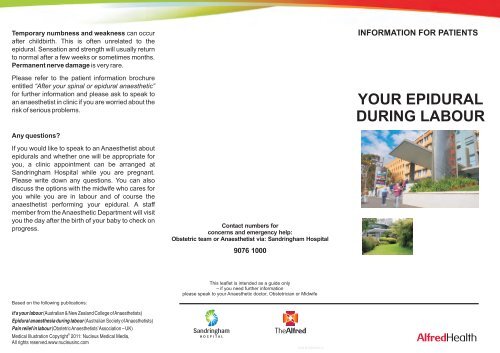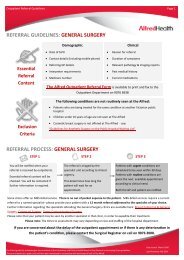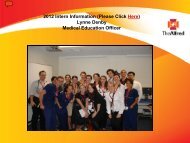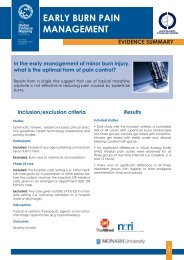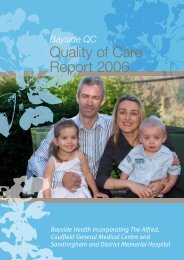Your epidural during labour - Alfred Hospital
Your epidural during labour - Alfred Hospital
Your epidural during labour - Alfred Hospital
Create successful ePaper yourself
Turn your PDF publications into a flip-book with our unique Google optimized e-Paper software.
Temporary numbness and weakness can occurafter childbirth. This is often unrelated to the<strong>epidural</strong>. Sensation and strength will usually returnto normal after a few weeks or sometimes months.Permanent nerve damage is very rare.Please refer to the patient information brochureentitled “After your spinal or <strong>epidural</strong> anaesthetic”for further information and please ask to speak toan anaesthetist in clinic if you are worried about therisk of serious problems.INFORMATION FOR PATIENTSYOUR EPIDURALDURING LABOURAny questions?If you would like to speak to an Anaesthetist about<strong>epidural</strong>s and whether one will be appropriate foryou, a clinic appointment can be arranged atSandringham <strong>Hospital</strong> while you are pregnant.Please write down any questions. You can alsodiscuss the options with the midwife who cares foryou while you are in <strong>labour</strong> and of course theanaesthetist performing your <strong>epidural</strong>. A staffmember from the Anaesthetic Department will visityou the day after the birth of your baby to check onprogress.Contact numbers forconcerns and emergency help:Obstetric team or Anaesthetist via: Sandringham <strong>Hospital</strong>9076 1000This leaflet is intended as a guide only– if you need further informationplease speak to your Anaesthetic doctor, Obstetrician or MidwifeBased on the following publications:It's your <strong>labour</strong> (Australian & New Zealand College ofAnaesthetists)Epidural anaesthesia <strong>during</strong> <strong>labour</strong> (Australian Society ofAnaesthetists)Pain relief in <strong>labour</strong> (ObstetricAnaesthetists’Association – UK)®Medical Illustration Copyright 2011: Nucleus Medical Media,All rights reserved.www.nucleusinc.comVCS G10725 02-11
What is an <strong>epidural</strong>?An <strong>epidural</strong> is a very effective way to relieve <strong>labour</strong>pain. Epidurals in <strong>labour</strong> have an excellent safetyrecord and have been used by millions of women.<strong>Your</strong> <strong>epidural</strong> is performed by an Anaesthetist (adoctor trained in anaesthesia).First a needle is inserted between two vertebrae inthe lower back into the <strong>epidural</strong> space. Then a fineplastic tube (called a catheter) is threaded into the<strong>epidural</strong> space and the needle is removed. Thecatheter is then taped in place and pain relievingmedication is administered through the catheter.The pain relief is tailored to your needs using thecatheter for as long as necessary <strong>during</strong> (and after)your <strong>labour</strong>.Usually the procedure takes around 15-20minutes, with a further 15-20 minutes before the<strong>epidural</strong> medication becomes fully effective.Occasionally a one-off injection is also given intothe spinal fluid which results in faster onset of thepain relief. This is called a combined spinal<strong>epidural</strong>anaesthetic.Low doses of anaesthetic are generally used sothat the sensation of your contractions is retainedwithout the pain and without causing too muchnumbness or leg weakness. You should be able tofeel enough to push effectively when required.You will need an intravenous drip and additionalmonitoring with an <strong>epidural</strong>, such as regular bloodpressure measurements and continuous fetalheart monitoring.Epidural services are available 24 hours a day atSandringham <strong>Hospital</strong>.AnAnaesthetist is availableat all times but may be on-call from home, meaninga short delay is possible on some occasions.Why have an <strong>epidural</strong>?© Nucleus Medical Media ®There are many ways to deal with <strong>labour</strong> pain. It is agood idea to have an open mind and be flexible.An <strong>epidural</strong> provides more effective pain relief thanany other method. This may make the experienceof <strong>labour</strong> and delivery more satisfying for you andyour birth partner. Side-effects of other methods ofpain relief can also be avoided by having an<strong>epidural</strong> (such as nausea and sedation frombreathing gas and air or pethidine injections).An <strong>epidural</strong> may be recommended by yourObstetrician in combination with medication tomake your contractions stronger. There are alsomedical reasons for having an <strong>epidural</strong> whichinclude high blood pressure, diabetes and twinpregnancy. An <strong>epidural</strong> can usually be topped upand can be used for a Caesarean section or otheroperations if required.When should you not have an <strong>epidural</strong>?In some situations an <strong>epidural</strong> may not be safe –when there is an increased risk of bleeding orinfection in the spine, for example. If you have amedical condition including heart disease,previous back operations and blood clottingproblems, you should have a consultation in thePre-Anaesthetic assessment clinic <strong>during</strong> yourpregnancy, well before you go into <strong>labour</strong>. Pleasealso tell us if you have any allergies or have had abad reaction to an anaesthetic.If you are overweight an <strong>epidural</strong> is often moredifficult and takes longer to put in place, but once it isin you will have all the usual benefits.What side-effects can an <strong>epidural</strong> cause?An <strong>epidural</strong> may cause one or more of the followingside-effects: Amild to moderate drop in blood pressure Temporary weakness in your legs Shivering, although you won't feel cold Itchiness, which can be treated if severe Trouble passing urine Some tenderness at the site of insertion Failure of the <strong>epidural</strong> requiring replacementAn <strong>epidural</strong> makes a suction cap or forceps deliverymore likely (especially if this is your first <strong>labour</strong>),although Caesarean section is not more commonwith an <strong>epidural</strong>. There is no evidence that an<strong>epidural</strong> will have any significant effect on your baby.Headache occurs in around 1 in 150 <strong>epidural</strong>sowing to accidental puncture into the spinal fluid.The headache is usually treated effectively with a“blood patch” which is like another <strong>epidural</strong>.


